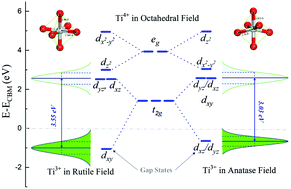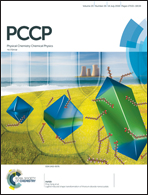Electronic structure and photoabsorption of Ti3+ ions in reduced anatase and rutile TiO2†
Abstract
We have used two-photon photoemission (2PPE) spectroscopy and first-principles density functional theory calculations to investigate the electronic structure and photoabsorption of the reduced anatase TiO2(101) and rutile TiO2(110) surfaces. 2PPE measurements on anatase (101) show an excited resonance induced by reduced Ti3+ species centered around 2.5 eV above the Fermi level (EF). While this state is similar to that observed on the rutile (110) surface, the intensity of the 2PPE peak is much weaker. The computed oscillator strengths of the transitions from the occupied gap states to the empty states in the conduction band show peaks between 2.0 and 3.0 eV above the conduction band minimum (CBM) on both surfaces, confirming the presence of empty Ti3+ resonances at these energies. Although the crystal field environment of Ti ions is octahedral in both rutile and anatase, Ti3+ ions exhibit distinct d orbital splittings due to different distortions of the TiO6 units. This affects the directions of the transition dipoles from the gap states to the conduction band, explaining the polarization dependence of the 2PPE signal in the two materials. Our results also show that the Ti3+ induced states in the band gap are shallower in anatase than in rutile. The d → d transitions from the occupied gap states to the empty Ti3+ excited states in anatase can occur at energies well below 3 eV, consistent with the observed visible-light photocatalytic activity of Ti3+ self-doped anatase.

- This article is part of the themed collection: 2018 PCCP HOT Articles


 Please wait while we load your content...
Please wait while we load your content...
